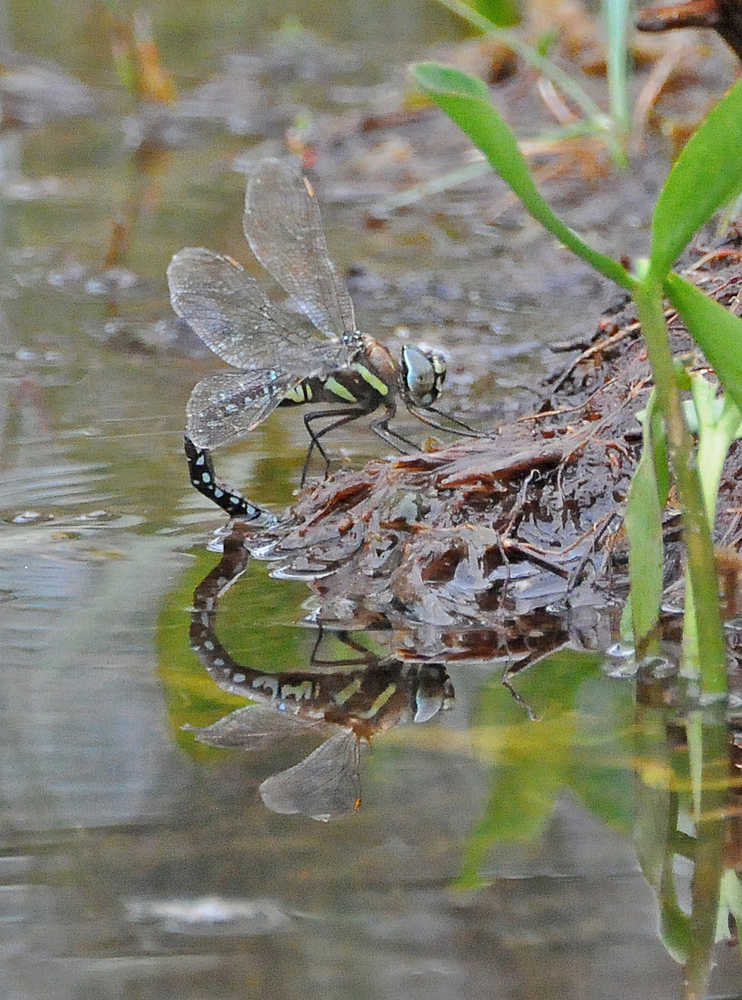One sunny day in late August, a friend and I headed up to the meadows at the base of Mount Jumbo, just above the Treadwell Ditch. On the way, we stopped to check on a rumor that a new bridge over Paris Creek had been completed. But no! A tidy new gravel path leads down to the creek, a short distance downstream of the precarious old crossing (over the old wooden dam); a neat new gravel path leads up the other side of the creek, to regain the regular Ditch Trail. But no bridge at all yet, just a large log parked cattywompus across the creek. Hikers with good balance (apparently) have trod across this makeshift bridge and hopped up on the far bank.
Along the Ditch Trail we spotted a tall snag with at least 17 woodpecker holes carved in its sides. It is unlikely that more than one of these was occupied in any one season, but several holes had signs of relatively recent occupancy; the wood around the opening was not very weathered. Of course, we wondered what made that particular snag so popular. There are other big ones to choose from, in that area.
Then we went on up to prowl around the meadows, finding a nifty yellow-and-brown-striped caterpillar that probably mimics a twig and a few ripe bog cranberries. As we perched on a handy log for a snack, a small, brownish bird executed some fine aerobatics in pursuit of an insect. Its travelling companion perused the lower levels of the short pines, and we then could see its bright yellow rump patch. Oh yes, yellow-rumped warblers, which are known to do a lot of aerial fly catching in addition to gleaning leaves. Overhead, we heard soft chips as other birds held a conversation. Looking up, we saw we’d been joined by a couple of kinglets, busily looking for bugs amid the pine needles.
We chanced upon a big dragonfly, the kind known as a blue darner (we have several species here), inspecting one of the muskeg ponds and occasionally touching the mucky banks with the tip of her abdomen. She was ovipositing her eggs into the decaying vegetation and mud that line the pond banks. We watched for several minutes as she moved carefully around the edge of the pond, pausing several times to touch down and deposit an egg. If each of those eggs hatched, there could be 10 or 12 predatory, voracious larvae in this small pond, only about three feet by six feet. Could such a small pond support that many growing offspring — or even just one? The answer seems to be yes. A few days later in another small pond, I found three shed larval exoskeletons, left behind when adults emerged. But what are they eating? And how many ponds would the female visit before exhausting her supply of fertilized eggs?
Two days later, on another sunny day, I wandered up into another muskeg that had several small ponds. After splodging around in the muck and wet moss for a while, I settled down on a raised hummock of semi-dry moss and small shrubs, with a small pine for a backrest. I told myself that I was watching dragonflies although the main excuse was probably basking in the sun’s rays for a while.
Blue darner dragons indeed were busy, patrolling and foraging over this set of little ponds, but there was no visible oviposition. So these were probably males. There seemed to be one individual that favored the lower, largest pond, and another that zipped around the upper, smaller ones; still others flew in from time to time. It became hard to be sure who was who; trespassers were chased vigorously and sometimes lengthily, either to drive away competition or in hopes of finding a willing female with which to mate. I could hear the wings rattle in their close encounters, even when they were out of sight. One chase resulted in a male’s attempt to grab a presumed female by hooking the claspers at the end of his abdomen behind the other one’s head. I was hoping to see them join in the tandem flight, linked together tail to head, followed by the well-known loop formed by the two bodies when the captured female bends up the end of her abdomen to contact his abdomen just behind the thorax. He has stored his sperm in a chamber there, and that’s how her eggs get fertilized. But no luck. This coupling attempt was aborted with much rustling of wings, and both darners went on their ways.
At my feet I saw the remains of a dragonfly that had been thoroughly eaten by some predator, perhaps a bird. All that was left were the wings and the empty husk of the thorax; head and abdomen were entirely gone. It takes some doing to capture a fully mature dragonfly, unless low temperatures slow it down.
I picked myself up off my not-so-dry perch, equipped with wet britches and a mouthful of early ripe bog cranberries. A contented hour in the sun.
• Mary F. Willson is a retired professor of ecology.

